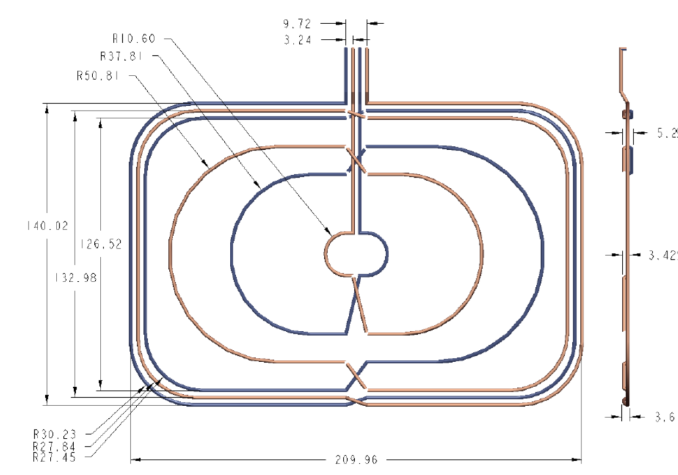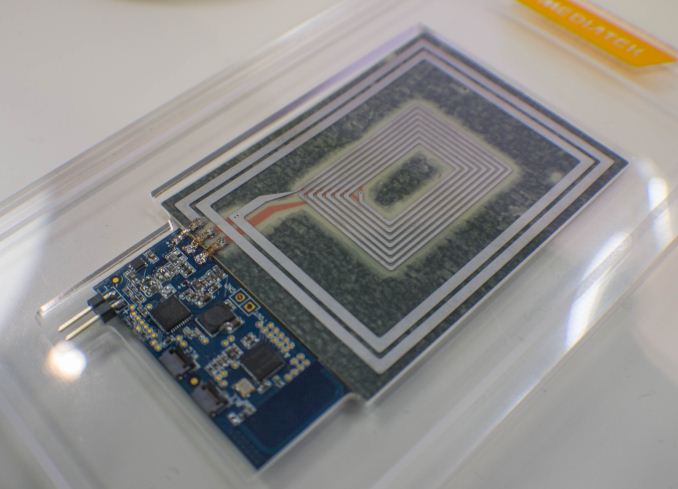The State of Wireless Charging Standards in Mobile
by Andrei Frumusanu on April 2, 2015 8:00 AM ESTRezence Resonance Charging
Earlier we saw the distinction between tightly coupled (TC) and loosely coupled (LC) induction charging systems. While A4WP’s Rezence system is called a magnetic resonance charging system, the basic principle is still based on magnetic induction. The critical difference between Qi and Powermat standards is that it is a Rezence is based on a loosely coupled coil system.
Inductive power frequencies and use-cases (Source)
A4WP systems work on a much higher frequency compared to tightly coupled systems such as defined by PMA and WPC. Rezence’s operating frequency is defined on a strict 6.78MHz (±15kHz) band compared to the 110-357kHz range that Qi and Powermat operate in.
Instead of a tight coil on the transmitter and receivers, we see the usage of a specifically shaped resonator designs. An A4WP transmitter has typically larger footprint than Qi or Powermat designs, with various classes of designs available depending on power requirement. Currently the widely adopted one is the Class 3 transmitter which has a size of 204x146mm and meant for smartphone device use-cases.


A4WP Class 3 spiral type 235-135 power transmit resonator (Source 1, Source 2)
The class system allows A4WP for a variety of size power transmitter unit (PTUs) and power receiving unit (PRUs) resonator coil systems depending on the number of devices and power you are targeting to charge. The class 3 PTU supports up to 16W transmit power.
| PTU Class | Maximum transmission in power |
Minimum PRU Support |
| Class 1 | TBD | >1 x Category 1 |
| Class 2 | 10W | 1 x Category 1, 2, or 3 |
| Class 3 | 16W | 2 x Category 1,2, or 3, or 1 x Category 4 |
| Class 4 | 22W | 3 x Category 1, 2, or 3, or 1 x Category 4 |
| Class 5 | TBD | TDB |
| PRU Category | Maximum reception out power |
Example Applcations |
| Category 1 | TBD | BT headset |
| Category 2 | 3.5W | Feature Phone |
| Category 3 | 6.5W | Smart Phone |
| Category 4 | TBD | Tablet |
| Category 5 | TBD | Laptop |
The current PRU categories are mainly defined for feature phone and smartphone devices with output powers of respectively 3.5 and 6.5W. We should be seeing class 3 devices as the most prevalent category implemented in smartphones in the near future. A class 3 PTU can charge at least two class 3 PRUs at full power, which should be sufficient for most use-cases.
A4WP WPT multi-device charging architecture (Source)
As mentioned before, the LC design of the Rezence charger allows for multiple receivers for a single transmitter, enabling a "star network" of PRUs for each PTU.
While Qi and Powermat respectively use either modulation on the power signal and RFID for communication between the transmitter ans receiver devices, Rezence work with a Bluetooth Low Energy (BLE) connection between all the different actors. There is no device pairing involved as communication is done over GATT (Generic Attribute Profile), a BLE feature.
At MWC2015 multiple vendors were demonstrating their A4WP implementations and chargers, and it was much more impressive to see them in action compared to the TC systems such as Qi and Powermat. Mediatek had a vertically standing Rezence charger which was demonstrated on a Galaxy S4 with custom backplate integrating Mediatek's tri-standard charging solution and powering the device via the dedicated power pins.
Practically, Rezence also seems to be the better solution as one doesn't have to deal with alignment of the device on the charging surface. Charging surfaces can vary in size and have an advantage of reduced complexity as it still remains a single resonator coil, where as Qi requires multiple overlapped coils to achieve the same effect and Powermat doesn't allow such flexibility in the first place.
Closing Thoughts
Having shed a bit more light on the difference and characteristics of the three main charging standard today, the question is on how the future of wireless charging will look. There is an undisputable battle of politics going on between the different standards associations, with each wanting to have their say and their own solutions to the wireless power transfer problem. Though right now the odd man out in all of this is the PMA, as it's hard to argue that Powermat brings any tangible advantages over Qi, not to mention it's a much less widespread standard.
Rezence from the A4WP on the other hand seems to be promising. The A4WP sees tightly coupled systems as first-generation technology that will in the future be replaced by loosely coupled charging implementations such as Rezence. I don't think the lesser charging efficiency will be something that people will mind as the practicality improvements clearly outweigh the disadvantages. The PMA-A4WP merger is seen as a technology swap as the A4WP gains access to a tightly coupled standard and the PMA gets access to a loosely coupled standard.
Meanwhile the WPC is working on its own resonance based loosely coupled system to compete with Rezence, but it's still in the development and we don't yet have much information on it.

MediaTek's tri-standard charging solution demonstration board
IC designers are going forward with tri-standard compatible solutions for wireless charging and that's what I envison will be the the aim for most device manufacturers who will want to include wireless charging into their products. This solves the device compatibility issue, but doesn't solve the problem completely as not all devices will be able to adopt it due to differing form factors. Rezence here again offers the best offering for form factor diversity, power transfer and charger interoperability. Though with the number of factions involved in this battle, it's not necessarily a given that this will be a battle won by technology as opposed to politics.
Ultimately the wireless charging ecosystem has changed a lot over the last few years, and things could again change drastically over the next few years, so nobody knows for sure in which direction the market will shift. We'll be sure to keep an eye on WPT in the future and cover any emerging news on the topic.












90 Comments
View All Comments
blanarahul - Thursday, April 2, 2015 - link
The biggest problem with wireless charging for me is significant power efficiency losses, additional heating up and hence reduced lifetime of smartphone batteries which can't be replaced, thicker phones and (not completely sure) slower charging. It's simply not worth the 2 seconds it takes to remove/insert the cord from the phone.Spoogie - Thursday, April 2, 2015 - link
But it's never really 2 seconds, is it.blanarahul - Thursday, April 2, 2015 - link
With Micro USB Type-C it will be. Short distance wireless charging is worthless to me. I'd rather have the extra space be spent on putting larger batteries.lilmoe - Thursday, April 2, 2015 - link
I think Spoogie meant that it's not only about "connecting" your charging cable (regardless of type). Taking out your charger and looking for a free socket can prove to be hassle.That said, I agree with you. I'd "prefer" simplifying the internal design of the device (making repairs easier) and installing a beefier battery instead of wireless charging. But having both does have its benefits.
My real problem with wireless charging on the go is that your device needs to be stationary, ie: you don't have the convenience of using your device semi-freely like you would when its tethered with a fairly long cable. It's only charging when you're generally not using the device, unless you have a bluetooth or wired headset. You "solve" an inconvenience just to be faced with others.
nathanddrews - Thursday, April 2, 2015 - link
We use wireless chargers mostly because the USB ports are failing (wear and tear). $20 Qi chargers are cheaper than new phones. I'll be happier once we get whole-home wireless power transmission.blanarahul - Thursday, April 2, 2015 - link
I can't wait to see the ridiculous SAR/(or it's wireless power equivalent) values wreak havoc on your nervous system when you switch to whole home wireless power.Lord of the Bored - Friday, April 3, 2015 - link
Spoilers: Those magnetic fields wireless power connectors use? The ones induced by alternating current flow through a wire? They're ALREADY being generated by every electrified wire in your home. If wireless power was going to fry your brains, we'd already be dead.(Tangentally, electromagnetic fields and RF radiation are fundamentally different beasts and not really comparable like that. Yes, I did look up SAR to figure out what the hey you were talking about.)
Fortunately, aside from it not actually being an issue, magnetic fields fall off rapidly with distance. That's why inductive power connections require very short distances. You may remember Apple used to use inductive power connectors on their laptops, and you still had to run a cable from the charger to the computer anyways.
Coincidentally, that falloff is ALSO why whole-house wireless power isn't likely to go anywhere. Since you have to run cords from your devices to your power outlets ANYWAYS, you may as well keep using the same dead-simple, cheap to manufacture "legacy" power connector you always have. It was a problem in Nikola Tesla's time, and it's a problem in our's as well. Physics is a real drag sometimes.
JonnyDough - Saturday, April 4, 2015 - link
Not only are we polluting ourselves with radiation, but other creatures such as bees are supposedly being interfered with as well. Cancer is at an all time high, despite the lowering of chemical pollutants in industry and fewer smokers.jospoortvliet - Sunday, April 5, 2015 - link
try using logic here for a sec. People die, right? I mean nobody can live forever. There is a bunch of things you can die off. Starting with war and murder, then bacterial, virus and parasitic infections. What happens if you eliminate most of that? The next in line becomes the most killing. Cancer. but in places with war and bad health care, there is still 'no Denver's because the other stuff kills people. despite them having mobile phones and electricity.As usual, conspiracy theories require actually more fantastic things to be true than reality... I'm sure there is a theory you have that explains all I said - but it will be nonsense.
omems - Saturday, April 11, 2015 - link
jospoortvliet is spot on. now that we're not dying from polio and the flu, we can die from heart disease and cancer. here's some actual data, excerpted from the NEJM.http://www.businessinsider.com/leading-causes-of-d...
if you have access, the original article has a good interactive chart that might be more intuitive.